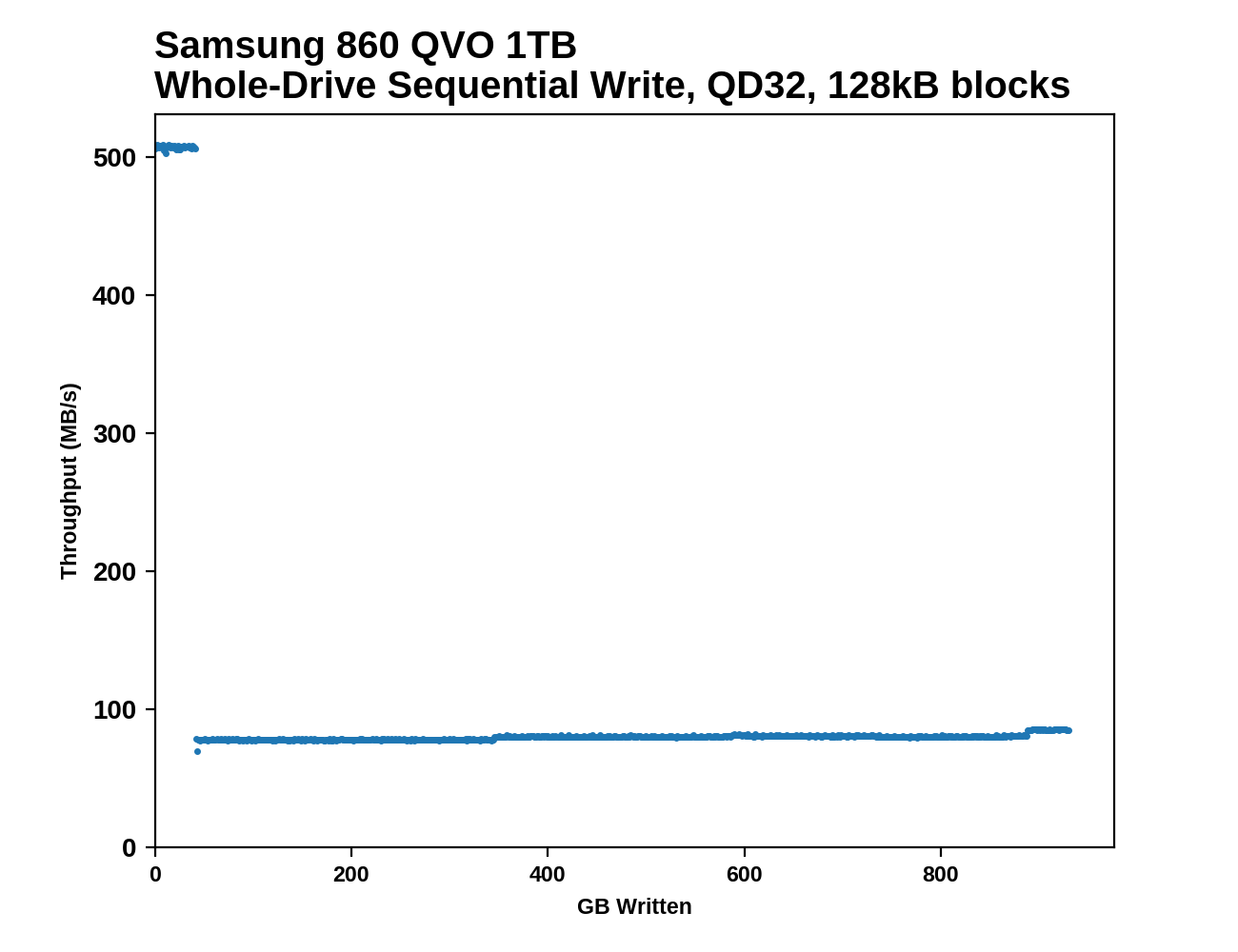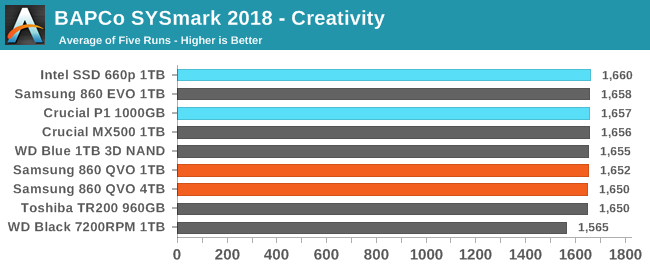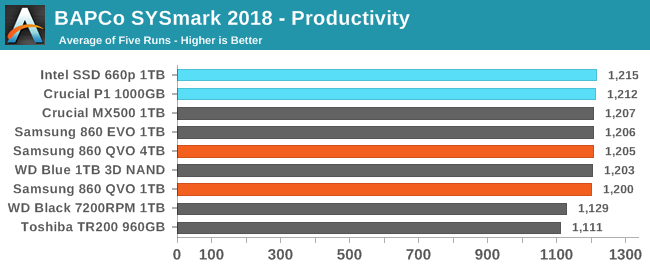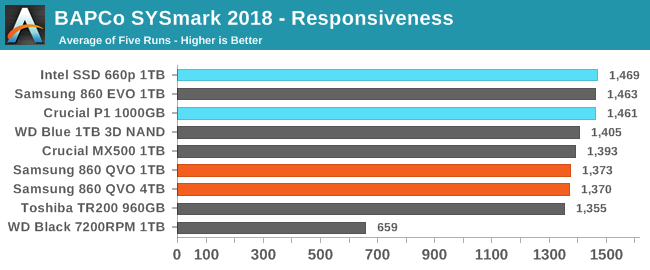The Samsung 860 QVO (1TB, 4TB) SSD Review: First Consumer SATA QLC
by Billy Tallis on November 27, 2018 11:20 AM ESTWhole-Drive Fill: Testing SLC Cache Size
This test starts with a freshly-erased drive and fills it with 128kB sequential writes at queue depth 32, recording the write speed for each 1GB segment. This test is not representative of any ordinary client/consumer usage pattern, but it does allow us to observe transitions in the drive's behavior as it fills up. This can allow us to estimate the size of any SLC write cache, and get a sense for how much performance remains on the rare occasions where real-world usage keeps writing data after filling the cache. Samsung's official specifications are:
| Samsung 860 QVO Secondary Specifications | |||||
| Capacity | 1 TB | 2 TB | 4 TB | ||
| SLC Cache Size |
Min | 6 GB | 6 GB | 6 GB | |
| Max | 42 GB | 78 GB | 78 GB | ||
| Sequential Write |
SLC Cache | 520 MB/s | |||
| QLC | 80 MB/s | 160 MB/s | 160 MB/s | ||
Our results show the following:
 |
|||||||||
The Samsung 860 QVOs run out of SLC cache right on schedule, at 42 GB for the 1TB model and 78 GB for the 4TB. After that, they are both slow and very steady for the rest of the test.
 |
|||||||||
| Average Throughput for last 16 GB | Overall Average Throughput | ||||||||
The 1TB 860 QVO falls below the sequential write speed of a 1TB hard drive once the SLC cache runs out, but the 4TB model is able to sustain twice the write speed and remains ahead of not just the hard drive's speed, but also some of the slower TLC drives.
BAPCo SYSmark 2018
BAPCo's SYSmark 2018 is an application-based benchmark that uses real-world applications to replay usage patterns of business users, with subscores for productivity, creativity and responsiveness. Scores represnt overall system performance and are calibrated against a reference system that is defined to score 1000 in each of the scenarios. A score of, say, 2000, would imply that the system under test is twice as fast as the reference system.
SYSmark scores are based on total application response time as seen by the user, including not only storage latency but time spent by the processor. This means there's a limit to how much a storage improvement could possibly increase scores, because the SSD is only in use for a small fraction of the total test duration. This is a significant difference from our ATSB tests where only the storage portion of the workload is replicated and disk idle times are cut short to a maximum of 25ms.
| AnandTech SYSmark SSD Testbed | |
| CPU | Intel Core i5-7400 |
| Motherboard | ASUS PRIME Z270-A |
| Chipset | Intel Z270 |
| Memory | 2x 8GB Corsair Vengeance DDR4-2400 CL17 |
| Case | In Win C583 |
| Power Supply | Cooler Master G550M |
| OS | Windows 10 64-bit, version 1803 |
Our SSD testing with SYSmark uses a different test system than the rest of our SSD tests. This machine is set up to measure total system power consumption rather than just the drive's power.



The 860 QVO isn't any slower for compute-heavy interactive tasks than the mainstream SATA SSDs, and even on the more I/O-bound Responsiveness test the 860 QVO is ahead of the DRAMless TLC drive and not far behind the Crucial MX500.
Energy Use
The SYSmark energy usage scores measure total system power consumption, excluding the display. Our SYSmark test system idles at around 26 W and peaks at over 60 W measured at the wall during the benchmark run. SATA SSDs seldom exceed 5 W and idle at a fraction of a watt, and the SSDs spend most of the test idle. This means the energy usage scores will inevitably be very close. A typical notebook system will tend to be better optimized for power efficiency than this desktop system, so the SSD would account for a much larger portion of the total and the score difference between SSDs would be more noticeable.

The Samsung 860 QVO's energy usage during SYSmark is not a problem at all, with it using slightly less energy than the mainstream SATA TLC drives.










109 Comments
View All Comments
nathanddrews - Tuesday, November 27, 2018 - link
Still leaps and bounds beyond 7200RPM hard drives, but not great either. If we could just get to SATA3 equivalent performance at this price/GB, it would be great. 4TB for that cheap is pretty awesome though, I might grab one if it goes on sale.Makaveli - Tuesday, November 27, 2018 - link
Your review conclusion was much easier on this drive than the Tech Report review.Basically buy a 860Evo this drive is trash is what I get when I read all the reviews on the net today. Only people that don't follow the industry will be suckered into buying these because of that attractive low price.
Like everything in this world you get what you pay for.
Billy Tallis - Tuesday, November 27, 2018 - link
I didn't want to over-emphasize the price issue because I don't think that situation will last very long. Samsung may end up dropping prices before the QVO even hits the shelves, and within a few months I think it will be significantly cheaper than the EVO, which means it should also be cheaper than all the other mainstream TLC drives and the handful of high-capacity DRAMless TLC drives. Once the novelty wears off and the pricing settles down, I fully expect the QVO to end up being a very reasonable entry-level buy.hanselltc - Wednesday, November 28, 2018 - link
It'll not only have to be significantly cheaper than the EVO series -- I think it'll have to compete with HDD arrays.The_Assimilator - Thursday, November 29, 2018 - link
This sort of forward-thinking bigger-picture non-knee-jerk reviewing is why I keep coming back to AnandTech. People can pan this drive and QLC all they want, but Samsung's gonna be laughing all the way to the bank once QLC starts eating HDDs' lunch, and then those same sites that trashed them will be calling them visionary.BTW Billy, please do keep us updated on the 4TB failures you saw - since that capacity is likely going to be the best in terms of cost/GB, a lot of people will be considering 4TB Samsung SSDs, and if there is a controller/firmware/NAND issue lurking it would be great to know about it beforehand.
AbRASiON - Tuesday, November 27, 2018 - link
Hi,I know it's an odd request but I don't follow reviews as much as I used to.
I'd love to see a couple of graphs on this chart, just showing perhaps a very early generation SSD or even a regular high end 7200RPM hard drive.
Scale is all but lost when you don't recognise the disks it's comparing against.
I know the 860/960 Evos are powerful, I can see this disk is much slower, but will it totally destroy a hard drive or Intel G2 160GB classic in all benchmarks? Etc
TekWiz - Tuesday, November 27, 2018 - link
Well sure it will destroy a hard drive! It's slower than the EVO but still is a pretty good SSD. It's aimed at people who want high capacity for as least money as possible. I bet if the list price is $150, it will probably end up costing about $20 less than an equivalent EVO.It's like comparing the PRO to the EVO, it's more expensive but has higher performance. But any of these quality SSD totally beat spinning disks particularly when it's not just sequential reads. In normal use, sequential reads are less common than the arm of the drive going back and forth over the surface reading blocks from all over the place, and you can hear it like a chattering sound, sometimes annoying. Those reads slow the drive down to a crawl usually. That's what makes the SSD so superior, there is no waste of time while a mechanical arm positions itself repetitively over various blocks on a spinning surface. On an SSD all the data is equally instantly available no matter where it exists in the cell matrix in the chips...
hanselltc - Wednesday, November 28, 2018 - link
Why would I want these over a HDD though? Say, a SSHD.CheapSushi - Wednesday, November 28, 2018 - link
Honestly I'd like for SSHDs to get a reboot, especially with this higher capacity QLC that also acts like SLC when needed. The current SSHDs I think have a max of 8GB of NAND and 2TB (I think) of platter. I'd love to see maybe 128GB of NAND and 4TB or 5TB of platter, at least for 2.5" form factor.Darcey R. Epperly - Wednesday, November 28, 2018 - link
And a reserved area guaranteed to be NAND, the rest for caching.